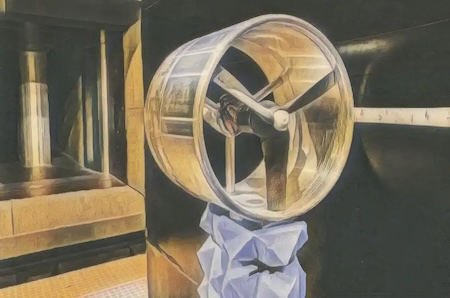Science Fiction
Dictionary
A B C D E F G H I J K L M N O P Q R S T U V W X Y Z
'Whisper Mode' ala Blue Thunder Researched At Bristol

The mystery of how futuristic aircraft-embedded engines, featuring an energy-conserving arrangement, make noise has been solved by researchers at the University of Bristol.

( Boundary layer ingesting (BLI) ducted fan test rig inside the aeroacoustics wind tunnel facility at the University of Bristol. )
Their study, published in Journal of Fluid Mechanics, reveals for the first time how noise is generated and propagated from these engines, technically known as boundary layer ingesting (BLI) ducted fans. The paper is titled "Aeroacoustics of a ducted fan ingesting an adverse pressure gradient boundary layer."BLI ducted fans are similar to the large engines found in modern airplanes but are partially embedded into the plane's main body instead of under the wings. As they ingest air from both the front and from the surface of the airframe, they don't have to work as hard to move the plane, so it burns less fuel.
The research, led by Feroz Ahmed from Bristol's School of Civil, Aerospace and Design Engineering under the supervision of Professor Mahdi Azarpeyvand, utilized the University National Aeroacoustic Wind Tunnel Facility. They were able to identify distinct noise sources originating from the duct, the rotating fan, and the air flowing over the curved airframe surface.
Fans of the outstanding 1983 movie Blue Thunder recall "whisper mode", referring to a special helicopter flight mode that was almost completely silent. Warning: this clip contains spoilers!
('Blue Thunder' whisper mode)
Scroll down for more stories in the same category. (Story submitted 4/18/2024)
Follow this kind of news @Technovelgy.| Email | RSS | Blog It | Stumble | del.icio.us | Digg | Reddit |
Would
you like to contribute a story tip?
It's easy:
Get the URL of the story, and the related sf author, and add
it here.
Comment/Join discussion ( 0 )
Related News Stories - (" Engineering ")
Tornyol Microdrone Kills Mosquitoes
'The real border was defended by... a swarm of quasi-independent aerostats.'
PLATO Spacecraft, Hunter Of Habitable Planets, Now Ready
'I ... set my automatic astronomical instruments to searching for a habitable planet.' Edmond Hamilton (1936).
Did The Yautja Have These First?
What a marvel of ingenuity the little device was! - Harry Bates, 1934.
Jetson ONE Air Races Begin, Can Air Polo Be Far Behind?
'If you're one of those rarities who haven't attended a rocket-polo "carnage", let me tell you it's a colorful affair.' - John Victor Peterson, 1938.
Technovelgy (that's tech-novel-gee!) is devoted to the creative science inventions and ideas of sf authors. Look for the Invention Category that interests you, the Glossary, the Invention Timeline, or see what's New.
Science Fiction
Timeline
1600-1899
1900-1939
1940's 1950's
1960's 1970's
1980's 1990's
2000's 2010's
Current News
Natural Gait With Prosthetic Connected To Nervous System
'The leg was to function, in a way, as a servo-mechanism operated by Larry’s brain...'
Woman Marries Computer, Vonnegut's Dream Comes True
'Men are made of protoplasm... Lasts forever.'
Spidery 'Walk Me' Toyota Autonomous Wheel Chair Like Star Wars
Walk along with the emperor.
Dancing Robots Taught Dance Moves
'A clockwork figure would be the thing for you...'
Proof Of Robothood - Not A Person
'Who are you people? - Show 'em.'
Indonesian Clans Battle
'The observation vehicle was of that peculiar variety used in conveying a large number of people across rough terrain.'
The 'Last Mile' In China Crowded With Delivery Robots
Yes, it's a delivery robot. On wheels.
Tornyol Microdrone Kills Mosquitoes
'The real border was defended by... a swarm of quasi-independent aerostats.'
PLATO Spacecraft, Hunter Of Habitable Planets, Now Ready
'I ... set my automatic astronomical instruments to searching for a habitable planet.'
Factory Humanoid Robots Built By Humanoid Robots
'...haven't you a section of the factory where only robot labor is employed?'
iPhone Air Fulfils Jobs' Promise From 2007 - A Giant Screen!
'... oblongs were all over the floor and surfaces.'
ChatGPT Now Participates in Group Chats
'...the city was their laboratory in human psychology.'
iPhone Pocket All Sold Out!
'A long, strong, slender net...'
Did The Yautja Have These First?
What a marvel of ingenuity the little device was!
Jetson ONE Air Races Begin, Can Air Polo Be Far Behind?
'If you're one of those rarities who haven't attended a rocket-polo "carnage", let me tell you it's a colorful affair.'
Will Space Stations Have Large Interior Spaces Again?
'They filed clumsily into the battleroom, like children in a swimming pool for the first time, clinging to the handholds along the side.'
